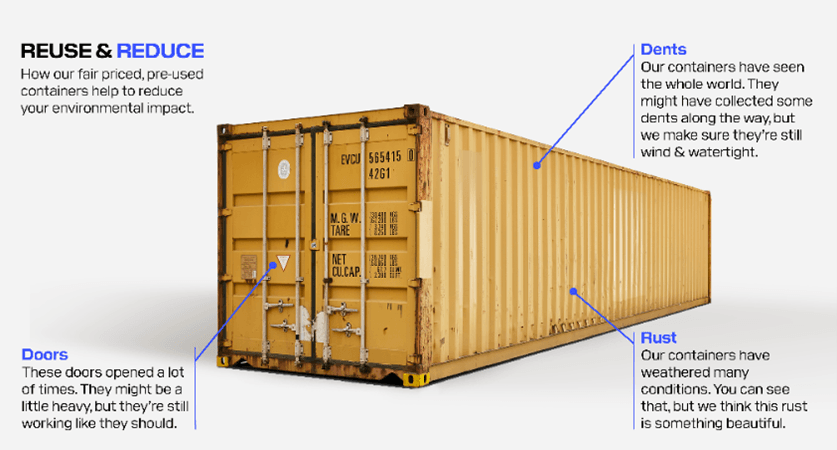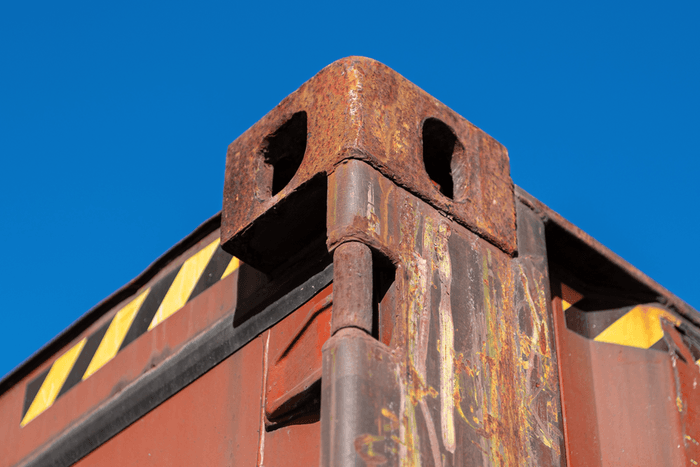SPRING SALE: Receive $100 Off Per Container
For decades, they have rolled past you on the highway, stacked high on cargo ships, and lined the ports of global commerce—unremarkable, utilitarian steel boxes that quietly power the world’s supply chain. The humble shipping container, which has transformed global trade and the world economy since the 1950s, is an incredibly strong and durable structure that deserves far more recognition.
At Eveon, we love shipping containers, admire their functionality and believe that while their days at sea are behind them, once decommissioned these metal structures can serve as a valuable land-based resource. Ready to serve, protect, shelter, move and store. Let's explore what shipping containers are made of, how they are constructed, and why they are the ideal tool and resource.

What Is A Shipping Container Made Of?
A common misconception is that the shipping container, invented by Malcom McLean to streamline and improve the efficiency of transporting goods, is a solid box. However, the floor of a container is not a single piece of solid metal or wood. Instead, it consists of marine-grade plywood laid over Corten steel-reinforced beams, providing both durability and structural integrity.
Corten steel, which is the same metal used to make bridges, roofs, fencing and transmission towers, is a high-strength steel alloy that forms a rust-like appearance when exposed to the elements. This makes it particularly well-suited for use in environments where durability & resistance to corrosion are essential. The Corten Steel beams run horizontally along the entire bottom of the container like a spine, this design with the metal cross members is primarily for structural integrity, weight reduction, and efficient load distribution.
When combined with Corten steel, Marine-grade Plywood flooring is durable and able to withstand the harsh conditions whether on land or sea.
Why Are Shipping Container Floors Made With Crossbeams:
- Strength & Load Bearing: The cross members act like the vertebrae of a spine, providing structural strength while allowing the floor to support heavy loads. This design helps distribute weight evenly across the length and width of the container, preventing excessive stress on any single point.
- Weight Reduction: A solid metal bottom would significantly increase the container’s weight, making transportation more costly and inefficient. By using a frame structure with wooden or composite flooring panels, the container remains strong yet lightweight.
- Cost Efficiency: Building a container with a solid steel bottom would require more material, increasing production costs. The current design uses a combination of steel beams and plywood or bamboo flooring, balancing strength and affordability.
- Forklift & Handling Accessibility: The gaps between the cross members provide access points for forklifts to lift and transport the container more efficiently.
- Flexibility & Shock Absorption: Much like a spine, the cross-member structure allows slight flexing under heavy loads, preventing damage to the cargo and the container itself. A rigid solid metal bottom could be more prone to cracking or warping under stress.
This design ensures that shipping containers remain durable, cost-effective, and easy to transport while maintaining the necessary strength for carrying heavy cargo.

The Shipping Container Floor
The shipping container floor constructed from marine-grade plywood, is engineered to resist water, rot & fungal growth, making it ideal for environments subject to moisture and fluctuating temperatures. In a shipping container, marine-grade plywood flooring provides a strong, stable surface that can handle heavy cargo while offering better insulation compared to steel. Its high resistance to moisture also makes it less likely to warp or degrade under wet conditions, ensuring long-lasting performance for storage.
The numerous layers of plywood pressed together allowed it to take hits and blows without cracking. Some peeling is okay and won't affect the effectiveness if minimal. When combined with Corten steel, Marine-grade Plywood flooring is durable and able to withstand the harsh conditions whether on land or sea. Making the shipping container a perfectly functional partner in the field, worksite or farm.
To explore all the ways these durable structures can be repurposed, click here.
Frequently Asked Questions
A wind and watertight shipping containers is a used shipping container that is between 10 – 15 years old and retired (decommissioned) from the container shipping lines.
You can expect visible dents and rust but what is most important is that the shipping container is wind and watertight and in good condition. This means it to have no cracks or holes, the floor is in good condition and that the door seals are tight enough to keep out any wind or water. If you were to stand inside the container with the doors closed, you should not see any light. It is important to get a WWT container to keep the goods you plan to store inside secure from weather elements.

Shipping containers are designed to keep everything inside safe from the environment, such as sun, snow, wind, and even rodents. However, there are a few things to consider as the seasons change....
Condensation Condensation is often one of the first things people experience inside a container. It can be a big problem, especially in winter.
With minus 20 outside and the sun shining, the outside of the container is warming up. When the sun heats the steel no longer matches the temperature inside the container. That is when condensation builds up.
If there is a temperature change between the air inside and outside the container, water droplets will appear. Instead of condensation building up on the outside of the container like a water glass, it will appear on the inside, called container rain.
Container rain occurs when water droplets appear on the container walls and ceiling and drip onto the floor or anything stored inside. This rain can lead to big problems in the future, such as mold, mildew and rust.
Make sure the items you’re packing are adequately sealed and aren’t damp. During the winter, unexpected moisture can cause things to warp or crack. During the spring thaw, humidity can attract pests and mold. Storing your items in vacuum-sealed bags, dry boxes, and with desiccants to ensure your items are safe no matter what.
Ventilation Condensation is a big issue in wintertime and colder climates, but it can happen anytime of the year and in other climates as well—especially humid ones. So no matter where you live, if condensation could be an issue, you need to install vents. You can install it on the end walls, container doors, and sidewalls. Best is to install 2 vents diagonally, so air can match the outside temperature.
Container Frozen to the Ground When a container is positioned directly on the ground without blocks underneath the corner posts, it might sink into the ground. Once it sinks into the ground and the ground freezes, your container is now frozen to the ground and can be nearly impossible to winch it out (if needed). If you plan to move your container during winter, ensure you have placed blocks beneath the corner posts so it's easier to move when you need to.
Roof Damage Another way to prepare for winter is to check your container for damage, such as rust or pinholes. During the winter, we sometimes get inches of snow at a time, and what you don’t want is for a large amount of snow to concave the container ceiling and cause irreparable damage to your container or items inside. Before winter hits, do a walk around of your container—especially the roof— and check for damages. See if there are any areas that hold water or places that are starting to cave in. Push out any dents holding water and silicone or caulk pinholes where the sun is creeping in.
Rodents Another problem that can cause issues during winter are rodents looking for shelter. They could sneak under your shipping container through the forklift pockets, or mice/birds could nest in the corner castings. Although shipping containers are rodent-free and they won’t be able to gnaw their way into the container, rodents such as skunks, foxes, rats or bunnies can still make the underside of the container their home during winter. These animals could cause health issues or problems later on.
**Maintain moving parts ** Keep an eye on the doors’ joints. By oiling and opening it now and then you can prevent the joint from rusting and fusing together. Make sure joints are clear of mud by rinsing the area with water and soap. WD-40 or other lubricants can be applied to joints and doors to help with functionality.
Check that container is sealed Look for any cracks or gaps in the walls; anything that affects the humidity and airflow can lead to sudden environmental changes within your shipping container.
No, it is typically not possible to see your container before delivery due to the operational processes and organization of depots.
Containers are usually stacked and arranged in a manner that makes it challenging for customers to access or view their specific container prior to delivery. The arrangement of containers is optimized for efficient storage and handling within the depot, often making individual container visibility difficult.
Once your container is loaded and sealed at the point of origin, it is transported to the depot for further processing and consolidation. During this period, customers usually do not have direct access to their container due to logistical reasons and security considerations.
While you may not be able to physically see your container before delivery, please note your delivery has been through an inspection process before leaving the depot. You will also sign off on an inspection form when your container is delivered.


